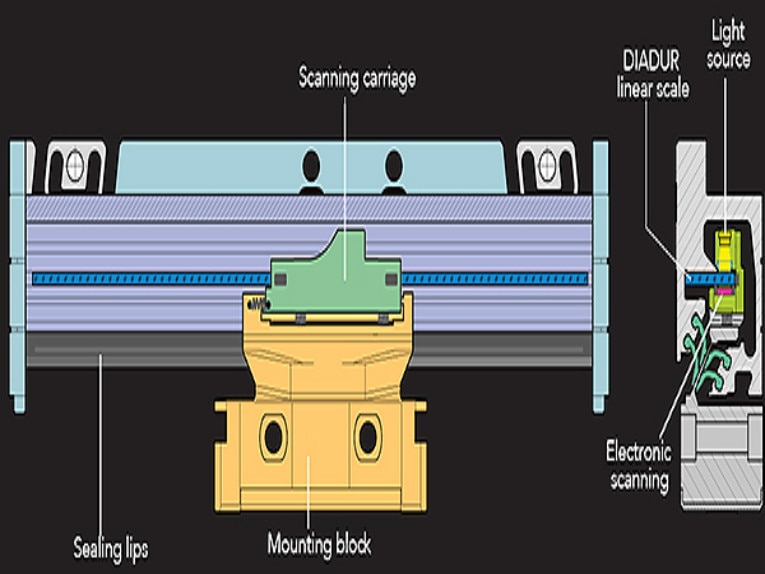Absolute or incremental, Optical or magnetic.
Linear encoders monitor linear movement and provide position feedback in the form of electrical signals. In servo driven systems, linear encoders supply the precise position of the load, typically in addition to the speed and direction feedback provided by the motor’s rotary encoder. For stepper driven systems, which typically operate in open-loop mode with no position feedback, adding a linear encoder increases the accuracy and reliability of the positioning system without the cost and complexity of a servo motor.
Feedback: Absolute or incremental
When selecting a linear encoder, the first thing to consider is what type of feedback is needed for the application—absolute or incremental. Absolute encoders assign a unique digital value to each position, which allows them to maintain precise position information, even when power is lost.
Incremental encoders work by generating a specific number of pulses per unit of travel and counting those pulses as the load moves. Because they are simply counting pulses, incremental encoders will lose their position reference if the power supply is interrupted. In order to determine the load’s actual position upon startup or re-start, a homing sequence is required. This means that the sensor (and the load) must move to a reference position, and from there it can begin to determine the load’s position. Keep in mind that even if the load’s actual position at startup or re-start is not critical, performing a homing sequence may be undesirable from a time and productivity standpoint. This is especially important in applications with long strokes and slow speeds, such as machine tools, where homing can be a time-consuming process.
The output for absolute and incremental encoders differs and is also a consideration for integration into the system’s control scheme. Absolute linear encoders produce a digital output, or “word,” that signifies the unit’s actual position. Resolution for an absolute encoder is determined by the number of bits in the word.
Incremental encoders produce quadrature output, with two channels that are 90 degrees out of phase. (The two channel output allows both position and direction to be monitored. If only position is needed, then only one channel is used.) Some incremental encoders produce a third channel with a single pulse, to be used as the index or reference position for homing. The number of pulses per distance (inch or millimeter) determines the resolution of an incremental encoder. However, resolution can be doubled by counting both the leading and trailing edges of the pulse from one channel, or it can be quadrupled by counting the leading and trailing edges of the pulses from both channels.
Technology: Optical or magnetic
Once the decision has been made regarding incremental or absolute feedback, the next consideration is whether the sensing technology should be optical or magnetic. While optical encoders have historically been the only option for resolutions below 5 microns, improvements in magnetic scale technology now allow them to achieve resolutions down to 1 micron.
Optical encoders use a light source and a photo-detector to determine position, but their use of light makes them sensitive to dirt and debris, which can disrupt the signal. The performance of optical encoders is highly influenced by the gap between the sensor and the scale, which must be properly set and maintained to ensure that signal integrity is not compromised. This means that mounting must be done carefully, and shocks and vibrations should be avoided.
Magnetic encoders use a magnetic reader head and a magnetic scale to determine position. Unlike optical encoders, magnetic encoders are mostly unaffected by dirt, debris, or liquid contamination. Shocks and vibrations are also less likely to affect magnetic encoders. They are, however, sensitive to magnetic chips, such as steel or iron, as they may interfere with the magnetic field.
While linear encoders are often an add-on component to a system, in many cases their benefits outweigh the additional labor and cost. For example, in ball screw driven applications, a lower accuracy screw can be chosen if a linear encoder is used, since the encoder feedback allows the controller to compensate for positioning errors introduced by the screw.
Post time: Jun-08-2020








